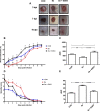Antimicrobial and anti-inflammatory effects of Eugenia brejoensis essential oil in mice wounds infected by Staphylococcus aureus
- PMID: 36313341
- PMCID: PMC9613942
- DOI: 10.3389/fphar.2022.999131
Antimicrobial and anti-inflammatory effects of Eugenia brejoensis essential oil in mice wounds infected by Staphylococcus aureus
Abstract
Eugenia brejoensis Mazine (Myrtaceae) is source of an essential oil (EbEO) with anti-infective activities against Staphylococcus aureus. This study evaluated the antimicrobial and anti-inflammatory potentials of EbEO in S. aureus-infected skin wounds. The excisional lesions (64 mm2) were induced on Swiss mice back (6 to 8-week-old) that were allocated into 3 groups (n = 12): 1) non-infected wounds (CON); 2) wounds infected with S. aureus ATCC 6538 (Sa); 3) S. aureus-infected wounds and treated with EbEO (Sa + EbEO). The infected groups received approximately 104 CFU/wound. The animals were treated with EbEO (10 µg/wound/day) or vehicle from the 1-day post-infection (dpi) until the 10th dpi. The clinical parameters (wound area, presence of exudate, edema intensity, etc.) were daily analyzed. The levels of inflammatory mediators (cytokines, nitric oxide, VEGF) and bacterial load were measured at the cutaneous tissue at 4th dpi and 10th dpi. Topical application of EbEO accelerated wound contraction with an average contraction of 83.48 ± 11.27 % of the lesion area until 6th dpi. In this period, the rates of lesion contraction were 54.28 ± 5.57% and 34.5 ± 2.67% for CON and Sa groups, respectively. The positive effects of EbEO on wound contraction were associated with significantly (p < 0.05) reduction on bacterial load and the release of inflammatory mediators (IL-6, IL-17A, TNF-α, NO and VEGF). Taken together, these data confirm the antimicrobial potential of EbEO and provide insights into its anti-inflammatory effects, making this essential oil an interesting candidate for the development of new therapeutic alternatives for infected cutaneous wounds.
Keywords: caatinga plants; host-pathogen interactions; infectious diseases; inflammatory mediators; skin healing; volatile compounds.
Copyright © 2022 Diniz, Fernandes, Mendonça, Silva, Saminez, Oliveira, Amorim, Figueiredo, Bezerra Filho, Correia, Silva, Sá Sousa, Zagmignan and Nascimento da Silva.
Conflict of interest statement
The authors declare that the research was conducted in the absence of any commercial or financial relationships that could be construed as a potential conflict of interest.
Figures




References
-
- Carneiro M., Silva L., dos S., Diniz R. M., Saminez S., Oliveira P., et al. (2021). Immunomodulatory and anti-infective effects of Cratylia mollis lectin (Cramoll) in a model of wound infection induced by Staphylococcus aureus . Int. Immunopharmacol. 100, 108094. 10.1016/J.INTIMP.2021.108094 - DOI - PubMed
LinkOut - more resources
Full Text Sources
Molecular Biology Databases

